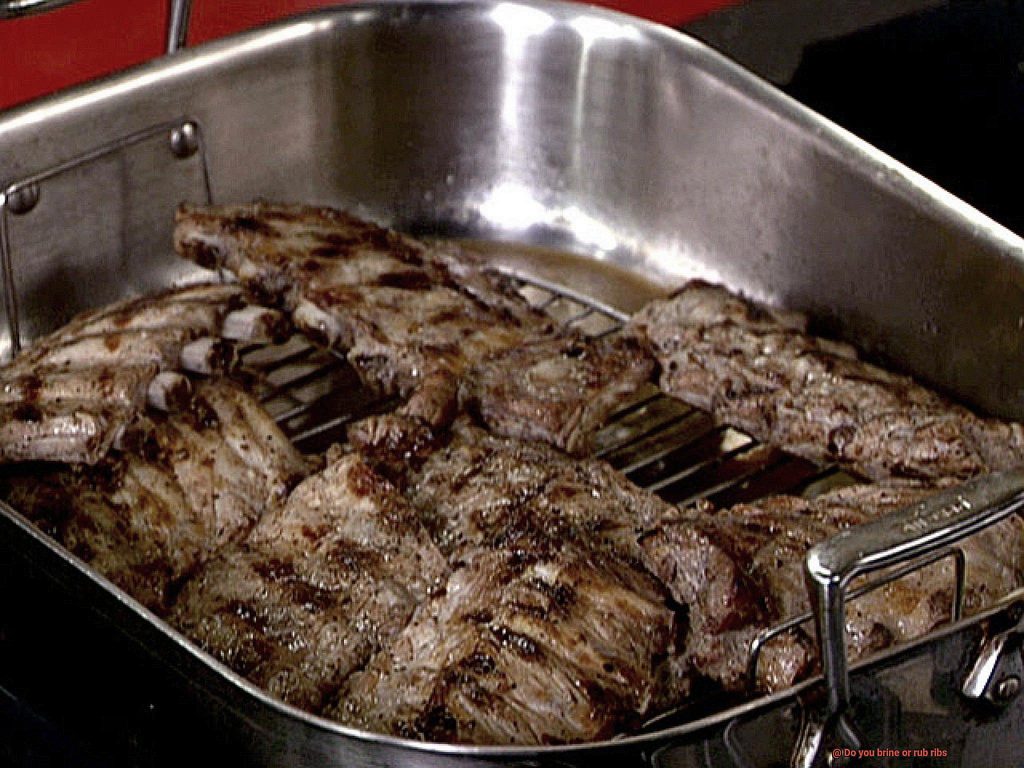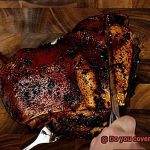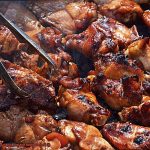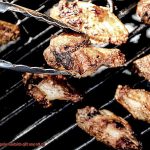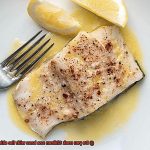If you’re all about those finger-licking, melt-in-your-mouth ribs, then you’ve probably pondered the age-old question of whether to brine or rub your meaty slabs. It’s a fiery debate that’s been sizzling on grills for ages. But fear not, because today we’re diving headfirst into the smoky world of ribs to uncover the secrets behind brining and rubbing. Get ready for a tantalizing journey as we weigh the pros and cons of each method.
Brining – ah, the art of soaking ribs in a salty bath. This ancient technique has long been hailed as a game-changer for infusing moisture into meat. Picture this: succulent ribs with every bite, thanks to the magical powers of salt. Not only does it enhance flavors and tenderize the meat, but it also keeps those babies from drying out during cooking. However, let’s be real – brining can be a bit time-consuming. You might have to wait hours or even overnight to achieve optimal results. And hey, while brined ribs are delicious, they may have a more subtle taste compared to their bold and flavorful rubbed counterparts.
Now let’s talk about rubbing – an explosion of herbs, spices, and seasonings that transforms your ribs into flavor bombs waiting to explode in your mouth. Picture yourself creating your own unique blend that perfectly suits your taste buds’ desires – smoky? Spicy? Sweet? Tangy? The choice is yours. Plus, rubbing is quick and easy-peasy lemon squeezy. It’s perfect for those spontaneous backyard barbecues where time is precious. But here’s the catch – without the moisture infusion from brining, there’s a teeny-tiny risk of your ribs drying out if you don’t keep a watchful eye on them while they cook.
Now, here’s where things get interesting. Some grill masters dare to venture into uncharted territory by combining both methods – the ultimate rib revolution.
They brine their ribs for that unbeatable tenderness and then slather on a mouthwatering rub for an explosion of flavors. It’s like hitting the jackpot of rib perfection.
Remember, my friends, in the quest for the perfect rib, don’t be afraid to get creative and experiment with different techniques until you find your signature style.
Contents
What is Brining?
Grilling ribs is a time-honored tradition that brings family and friends together, but sometimes achieving tender and juicy results can be a challenge.
That’s where brining comes in. In this blog post, we’ll dive into the world of brining and explore how this technique can take your grilled ribs to the next level.
Whether you’re a seasoned griller or a backyard enthusiast, understanding the art of brining will unlock a whole new realm of flavor and succulence.
The Science Behind Brining:
At its core, brining is a process that uses the power of osmosis to transform your ribs into mouthwatering masterpieces. By immersing the meat in a saltwater solution, the magic begins. The salt breaks down proteins in the ribs, allowing them to retain more water throughout the cooking process. This means that every bite is bursting with moisture and flavor.
The Brining Process:
Now that we understand the science behind brining, let’s break down the process step by step:
- Select your ribs: Choose high-quality ribs, such as spare ribs or baby back ribs, for optimal results.
- Create your brine: In a large container, combine water, salt, and other seasonings or flavorings of your choice. The possibilities are endless. From herbs and spices to sugar or even citrus zest, feel free to get creative and experiment with different combinations.
- Submerge the ribs: Place the ribs in the brine solution, ensuring they are fully submerged. You may need to weigh them down with a plate or heavy object to keep them fully immersed.
- Brine time: The length of time needed for brining depends on personal preference and the size of your ribs. As a general guideline, allow at least 2 hours for baby back ribs and up to 24 hours for larger cuts like spare ribs. For the impatient grillers out there, a quick brine of 30 minutes can still yield noticeable results.
- Rinse and pat dry: Once the brining time is up, remove the ribs from the brine and rinse them under cold water to remove excess salt. Pat them dry with paper towels to ensure a good sear on the grill.
- Grill to perfection: Fire up your grill to medium heat and cook the ribs until they reach the desired level of doneness. The brining process has already set you up for success, so all that’s left is to enjoy the tantalizing aroma and savor every bite.
Benefits of Brining Ribs
Then, it’s time to unlock the secret to tender and succulent ribs with the art of brining. Brining is a technique that involves soaking your ribs in a saltwater solution before cooking, and let me tell you, the results are absolutely drool-worthy.
First and foremost, brining helps to improve moisture retention. No one likes dry and tough ribs, right? Well, when you brine your ribs, the salt in the brine changes the structure of the meat, allowing it to hold onto more moisture. The end result? Juicy and succulent ribs that will have your taste buds dancing with delight.
But it’s not just about moisture. Brining also enhances the flavor of your ribs. The salt in the brine penetrates the meat, bringing out its natural flavors while also adding a subtle salty taste. And here’s the best part – you can customize your brine by adding herbs, spices, garlic, or even citrus zest to infuse additional flavors into your ribs. Talk about a flavor explosion.
Now let’s talk about texture. Brining helps to tenderize your ribs by breaking down the proteins in the meat. The salt in the brine denatures these proteins, making them more tender and resulting in ribs that are easy to bite into. Say goodbye to chewy ribs and hello to fall-off-the-bone goodness.
And let’s not forget about seasoning. When you brine your ribs, the salt and other seasonings in the brine evenly distribute throughout the meat, ensuring that every bite is packed with flavor. No more bland spots or uneven taste – just pure deliciousness from start to finish.
But wait, there’s more. Brining can actually save you time in the kitchen. Since the brine is absorbed by the meat during the soaking process, you don’t need to spend extra time waiting for the flavors to penetrate. This means you can spend less time marinating and more time enjoying your mouthwatering ribs.
What is Rubbing?
In the world of grilling and barbecuing, there’s an art form that can transform ordinary meat into extraordinary dishes – rubbing. The technique of rubbing involves coating the surface of the meat with a tantalizing blend of spices, herbs, and other seasonings. Not only does it enhance the taste, but it also creates a beautiful crust and tenderizes the meat. So, let’s dive into the world of rubbing and discover how you can master this essential grilling technique.
Choosing the Perfect Rub:
The key to a mouthwatering rub lies in the choice of ingredients. From smoky paprika to zesty chili powder, there are endless possibilities to suit your taste buds. Here are some common ingredients to get you started:
- Paprika: Infuses a rich color and smoky flavor.
- Chili powder: Adds a delightful kick of heat.
- Cumin: Provides earthy undertones for depth.
- Garlic powder: Infuses savory goodness into every bite.
- Onion powder: Adds complexity and depth to the flavor profile.
- Brown sugar: Balances out flavors with a touch of sweetness.
- Salt and black pepper: Enhances the overall taste experience.
Application is Key:
To ensure maximum flavor penetration, generously coat all sides of your meat with the rub mixture. Gently massage it into the meat, allowing it to adhere properly. This step not only adds flavor but also creates a tantalizing crust when cooked.
Beyond Flavor: Texture Enhancement and Tenderizing:
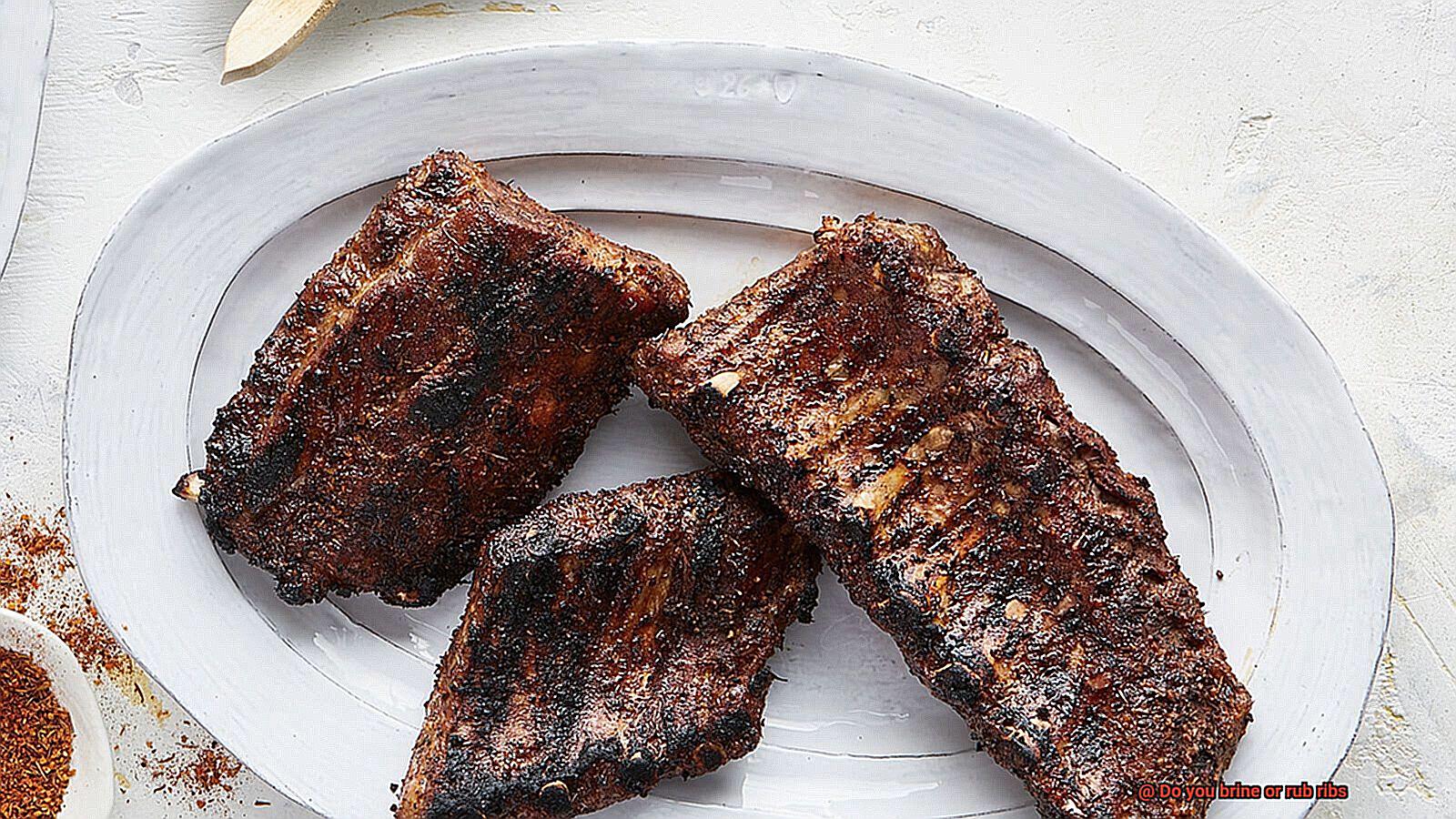
Rubbing doesn’t just add flavor; it also contributes to the texture of your dish. The dry exterior created by the rub helps develop a mouthwatering bark or crust during cooking, adding that perfect contrast in each bite. Additionally, certain ingredients in the rub can act as natural tenderizers, breaking down proteins and resulting in tender, succulent meat.
Benefits of Rubbing Ribs
In this blog post, we’ll embark on a tantalizing exploration of the mouthwatering benefits of rubbing ribs, uncovering why it’s a technique every griller should master.
Enhanced Flavor:
Prepare your taste buds for an explosion of flavor. The first benefit that springs to mind when discussing rib rubs is the unparalleled enhancement they bring to your meat. Picture a symphony of perfectly balanced sweet and smoky notes or a fiery dance of tangy spice – with rubs, the possibilities are endless. By skillfully blending spices, herbs, and seasonings, a well-crafted rub infuses your ribs with a tantalizing combination of flavors. These aromatic wonders penetrate the meat, creating a flavorful crust on the outside while keeping the interior tender and succulent.
Versatility:
Embrace the joy of endless possibilities. Another fantastic advantage of using rubs on ribs is their remarkable versatility. From sweet and smoky to spicy and tangy, there’s a rub recipe out there to suit every discerning palate. The power lies in your hands to customize your rub based on personal preferences, dietary restrictions, or even embark on daring experiments with unique flavor combinations. This freedom to create your own signature rub allows you to elevate your grilling prowess to new heights.
Time Efficiency:
Savor every second. Rubbing ribs proves to be a time-efficient method compared to traditional brining techniques. Bid farewell to tedious hours of waiting for meat to soak in a saltwater solution. With rubbing, you can swiftly apply the exquisite blend of spices onto the ribs just before grilling or smoking. A short resting period allows the flavors to permeate the meat, resulting in a delicious outcome without sacrificing precious time. Efficiency meets culinary excellence.
Bark Formation:
Indulge in texture and succulence. When spices and seasonings embrace your ribs, a desirable bark or crust forms during cooking. This caramelized layer not only adds a delightful crunch but also locks in moisture, ensuring tender and juicy meat. The bark enhances the overall eating experience, creating a delectable contrast between the crust’s complexity and the juicy morsels beneath. Prepare to be captivated by a symphony of textures.
Customization:
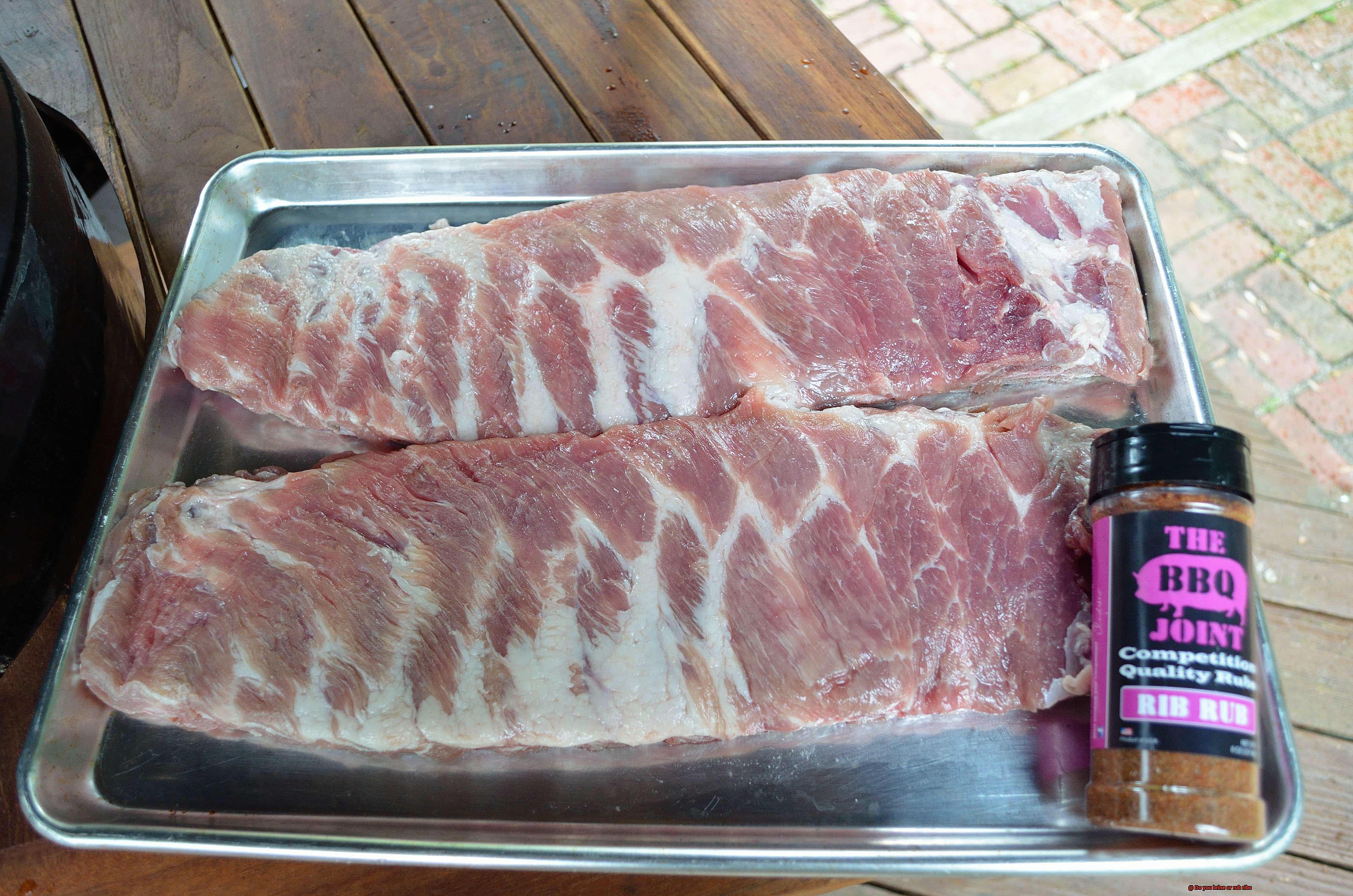
Unleash your creative flair. One of the joys of rubbing ribs is the opportunity for customization. Whether you crave a subtle flavor or yearn for an intense kick of heat, you wield complete control over the ingredients and their proportions when concocting your own rub. Take it a step further by experimenting with different rubs on various sections of the ribs, crafting a diverse flavor profile within a single rack. The result? A sensory journey that is uniquely yours.
Deciding Between Brining and Rubbing
When it comes to preparing ribs for the grill, the choice between brining and rubbing can make all the difference in flavor and tenderness. Brining involves soaking the ribs in a saltwater solution, while rubbing involves applying a dry spice mixture. Let’s dive into the details of each technique.
Brining is a game-changer for those seeking moist and tender ribs. By immersing the meat in a flavorful brine, the salt works its magic by breaking down proteins, resulting in melt-in-your-mouth goodness. You can customize the brine with various spices, herbs, and aromatics to elevate the taste even further. And fear not, brining also keeps your ribs from drying out on the grill.
To brine your ribs, simply dissolve salt in water to create a brine solution. Add your desired seasonings and submerge the ribs for several hours or overnight. Don’t forget to refrigerate during this process to keep bacteria at bay.
On the other hand, rubbing is a sizzling quick way to add a burst of flavor and create a crave-worthy crust on your ribs. With a mixture of herbs, spices, sugar, and salt, you can customize your rub to suit your taste buds’ wildest dreams. Rubbing is perfect for those with limited time but who still crave mouthwatering results.
To rub your ribs, combine your desired spices and herbs to create a tantalizing mixture. Generously apply this rub onto the surface of the ribs, ensuring every inch is coated with flavor. You can let the ribs marinate or cook them immediately.
When deciding between brining and rubbing your ribs, consider factors such as tenderness preference, available time, and personal taste. Both techniques yield scrumptious results, so choose what suits you best and get ready for a flavor-packed journey.
Combining Both Techniques
Get ready for a mouthwatering revelation – combining the art of brining and rubbing is the key to achieving the most tender and flavorful ribs you’ve ever sunk your teeth into. So, strap on your aprons and let’s dive into a world of flavor that will leave you craving more.
Let’s start by understanding the magic behind brining and rubbing. Brining involves immersing the ribs in a magical solution of salt, sugar, and an array of seasonings. This process infuses the meat with moisture and flavor while tenderizing it to perfection. On the flip side, rubbing involves generously coating the surface of the ribs with a heavenly blend of spices, creating a crust that will make your taste buds dance with joy.
Now, how do we bring these two techniques together? My fellow grill enthusiasts, there are a couple of approaches you can take. First, you can brine your ribs before anything else. Let them luxuriate in that flavorful solution for several hours or even overnight. Once they’re perfectly brined, it’s time to work your magic with the rub. Apply a generous amount of your favorite dry rub onto the surface of the ribs, ensuring it sticks like glue.
If you’re feeling adventurous, flip the script and apply the dry rub to your ribs before brining. This method allows those tantalizing flavors to penetrate deep into the meat during the brining process, resulting in an explosion of taste with each bite.
Timing is everything when it comes to combining these techniques. You don’t want to leave your ribs in the brine for too long; otherwise, they might become overly salty or lose their natural texture. Similarly, if you let that rub sit on for too long before cooking, it could suck out precious moisture from your meat, leaving you with a dry disappointment.
To achieve rib perfection, aim to brine your ribs for around 4-6 hours and then apply the dry rub just before cooking. This gives the brine enough time to work its magic without compromising the texture of the meat. Trust me, your taste buds will thank you.
Tips for Successful Grilling
Grilling ribs is an art form that requires a few essential tips and techniques to achieve perfection. Whether you’re a grilling novice or a seasoned pro, these key tips will help you elevate your rib game to new heights. Get ready to impress your family and friends with mouthwatering ribs that will have them coming back for more.
Cleanliness is Key:
Before you even think about firing up the grill, make sure it’s clean and free from any leftover residue. A sparkling clean grill ensures that your ribs won’t pick up any unwanted flavors and prevents charring. Take out your trusty grill brush and scrub away any debris from previous grilling sessions. A clean canvas sets the stage for deliciousness.
Preheat for Success:
Preheating the grill is crucial. It’s like priming a canvas before painting a masterpiece. Give your grill about 10-15 minutes to heat up before placing those ribs on the grates. This ensures that the grill reaches the desired temperature and helps to sear the meat properly. A sizzling hot grill creates those irresistible grill marks and locks in all that juicy goodness.
The Perfect Temperature:
When it comes to grilling ribs, choosing the right temperature is key. You want that delicate balance of tender meat and smoky flavor. For most ribs, a medium heat setting of around 300-350°F (150-175°C) works well. However, don’t be afraid to adjust the temperature based on the specific type of ribs you’re grilling. It’s all about finding that sweet spot where magic happens.
Indirect Heat is Your Friend:
Instead of placing the ribs directly over the flames, opt for indirect heat. This gentle cooking method allows flavors to develop slowly, resulting in tender, fall-off-the-bone goodness. Turn off one burner on a gas grill or place charcoal on one side of a charcoal grill for that indirect heat goodness. Let the ribs bask in the warmth and watch them transform into culinary masterpieces.
Monitor Internal Temperature:
Don’t leave the success of your ribs up to chance. Use a meat thermometer to monitor their internal temperature. This ensures that they’re cooked to perfection, avoiding any unpleasant surprises. For pork ribs, aim for around 145°F (63°C) for medium-rare and 160°F (71°C) for medium. For beef ribs, aim for around 135°F (57°C) for medium-rare and 145°F (63°C) for medium. It’s all about precision and achieving that melt-in-your-mouth texture.
a6c9xvwLLVM” >
Conclusion
When it comes to ribs, the debate between brining and rubbing is as intense as the flavors they impart. Some swear by the magic of brining, soaking their ribs in a flavorful solution to enhance tenderness and moisture. Others prefer the artistry of rubbing, massaging a blend of spices onto the meat for a burst of flavor that lingers on the taste buds.
Brining, oh brining. It’s like giving your ribs a luxurious spa treatment. Imagine those succulent slabs submerged in a bath of goodness – water, salt, sugar, herbs, and maybe even some citrus zest for that extra zing. As they soak up all those delectable flavors, the brine works its magic, tenderizing the meat from within and infusing it with moisture. The result? Ribs so tender you could practically pull them apart with a gentle tug.
Don’t underestimate the power of rubbing. Picture yourself standing over those glorious racks of ribs, armed with a mixture of spices that awaken every sense. You gently massage it into every nook and cranny, letting the flavors penetrate deep into the meat. As you cook those ribs low and slow, something magical happens – that spice rub forms a beautiful crust on the surface, locking in all those incredible flavors and creating an irresistible smoky bark.
So which camp do you belong to? Are you team brine or team rub? It ultimately boils down to personal preference and desired outcome. Brining gives you moistness and tenderness like no other while rubbing delivers an explosion of flavor that dances on your palate.
In conclusion, whether you choose to brine or rub your ribs depends on what you’re looking for – juicy tenderness or bold flavor fireworks. Whichever path you take, one thing is certain: when done right, both methods can elevate your rib game to mouthwatering heights. So go ahead, experiment with different techniques, and let your taste buds be the ultimate judge.

